Hard Work, High Achievement, and Immeasurable Impact
This is the printed version of the report delivered by Chancellor Mark A. Nordenberg at the June 27, 2008, annual meeting of the University of Pittsburgh Board of Trustees.
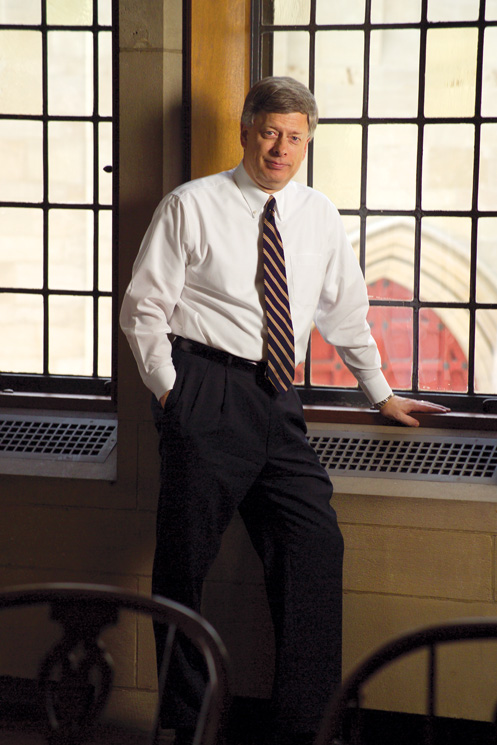
Mark A. Nordenberg
Thomas Edison once said, “Opportunity is missed by most people because it is dressed in overalls and looks like work.” That is a particularly telling observation, coming, as it did, from the “Wizard of Menlo Park.” Mr. Edison, of course, remains this country’s unquestioned champion when it comes to innovation: the holder of nearly 1,100 patents; the creator of the first industrial research laboratory; the inventor of such products as the incandescent light bulb, the phonograph, and the motion picture projector, not to mention the voting booth, which, at least in some places, seems not to have been improved since his day; and the founder of the company that became General Electric.
Decades later, in what we think of as the “age of innovation,” it is not unusual to hear the view expressed that there is a basic disconnect between the “blue-collar values” that made this region great and the “new- knowledge economy” that will provide the foundation for its future. Certainly, times have changed. But when you look at our home region’s earlier industrial history, the successes of corporations like Westinghouse Electric, U.S. Steel, PPG Industries, Alcoa, and H.J. Heinz were grounded not only in hard work but in smart work, tied to superior products and more efficient processes born through innovation.
And today, even in a 21st-century institution of higher learning and research, which is fueled by its intellectual power, hard work never has gone out of style. Think, for example, about the compelling news from a single day that we celebrated just a few weeks ago.
First, media outlets around the world highlighted the work done by a team of scientists led by Pitt Professor of Neurobiology Andrew Schwartz. The New York Times began its front-page article with the following description:
“Two monkeys with tiny sensors in their brains have learned to control a mechanical arm with just their thoughts, using it to reach for and grab food and even to adjust for the size and stickiness of the morsels when necessary. ...
“[This] is the most striking demonstration to date of brain-machine interface technology. Scientists expect that technology will eventually allow people with spinal cord injuries and other paralyzing conditions to gain more control over their lives.”
Paired with that story was a report that another Pitt team, this one led by Hillman Professor of Pediatric Immunology Massimo Trucco and his colleague Professor of Pathology Nick Giannoukakis, had developed a new vaccine approach that had prevented and even reversed new-onset cases of type 1 diabetes in animals. That approach currently is being tested in humans in a Phase 1 clinical trial that has been approved by the U.S. Food and Drug Administration.
We think of such developments as “breakthroughs”—and in terms of their advancement of scientific understandings, they are. But such advances do not just suddenly happen. Instead, though Mr. Edison’s overalls may have been converted into lab coats, these important forms of progress almost always are the result of tens of thousands of hours of effort, most often expended by large numbers of people over the course of many years.
The work that enables Pitt to continue moving forward involves contributions of countless types. Those contributions are made by committed members of our community, dressed in whatever attire is appropriate for their own institutional responsibilities.
The still-growing record of success crafted at the direction and with the support of this board is an enviable one: 13 consecutive years in which each and every year has been markedly better than the one that preceded it. That progress is the product of a well-developed ability to recognize and capitalize on a broad range of opportunities. And both seizing opportunities and meeting the challenges that typically travel with them have required creative thinking, high ambition, a commitment to mission, and a real appetite for hard work.
In terms of overall progress forged by that work, last year we celebrated the fact that Pitt had climbed into the very highest cluster of the country’s top public research universities in the annual assessment The Top American Research Universities, published by the Center for Measuring University Performance. That recognition was a source of special pride for a number of reasons.
• The clustering done in this study is tied to objective measures across key areas of performance—encompassing research, private support, faculty, graduate and postgraduate programs, and quality undergraduates—and is not simply another subjective survey of reputation.
• To climb from the fourth cluster, which already was a high ranking, in the inaugural 2000 study to the first cluster just six years later required that we improve our relative position with respect to 15 of this country’s finest universities, all formidable competitors and all committed to moving forward themselves.
• And reaching the top cluster put us in very distinguished company, as we joined just six other top-ranked institutions—Berkeley, Illinois, Michigan, North Carolina, UCLA, and Wisconsin.
Mindful of Irving Berlin’s admonition that “the toughest thing about success is that you’ve got to keep on being a success,” we were particularly heartened to learn, when this year’s The Top American Research Universities report was released, that its highest cluster was unchanged. There was Pitt, again in the top-ranked group.
When you are in the highest group, some might say that there is no room to rise. But we know that we have room to improve on multiple fronts. To convey some sense of our ongoing quest for ever-higher levels of quality, I want to focus on three key topics today: the continuing climb of Pitt students, the growing stature and impact of Pitt faculty members, and the increasing importance of Pitt’s private benefactors. In doing so, I will share some additional numbers, demonstrating both how far we have come and how our momentum continues to build. But I will spend even more time highlighting inspiring human examples.
The Continuing Climb of Pitt Students
The external review commissioned by this board in 1996 explicitly concluded that our “average SAT scores and high school rankings of the entire undergraduate entering classes” were “disappointingly low compared to the Association of American Universities cohort.” As a result, we made attracting higher-achieving undergraduates one of our highest priorities, and our continuing record of improvement—not only compared to our less-enviable position in the mid-1990s, but also to more recent years, which were themselves a source of shared pride—has been remarkable.
• In 1995, our baseline year, we attracted 7,825 applications for admission to the undergraduate programs on the Oakland campus. Last year, we received 19,056 applications, and this year, we are up to 20,639. Because of the very different starting points, it is hard to know whether the 164 percent increase since 1995 or the 8 percent increase in just the last year is more impressive. But trend lines show that we increasingly have become an institution of choice within the critical population of potential students. And from our larger applicant pool, we have been able to attract better
and better-credentialed students.
• In 1995, for example, our average SAT score was 1110. Last year, it was 1248, and this year (though these numbers may change some
over the course of the summer), we stand at 1265.
• And in 1995, just 19 percent of our freshmen had graduated in the top 10 percent of their high school classes. Last year, that number had risen to 48 percent, and this year, we currently stand at 50 percent.
Year after year, these accomplished high school applicants have become high-achieving Pitt undergraduates—one telling indication that we are discharging our most basic responsibility as an educational institution. In fact, our record as one of this country’s most consistent producers of top-performing undergraduates has become a defining institutional quality, and we continue adding to it.
• This year, for example, Eleanor Ott, a University Honors College junior with a triple major in chemistry, history, and French, was one of just 65 students nationally to be named a Truman scholar, a highly competitive award targeted to college juniors with exceptional leadership potential who are committed to careers in public service.
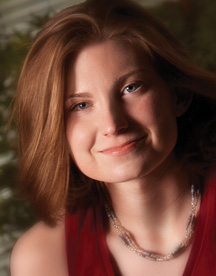
Eleanor Ott (A&S ’08)
• Both Todd Moyle, a University Honors College sophomore majoring in chemical engineering, and Charles Sleasman, a University Honors College junior majoring in physics and mathematics, were named Goldwater scholars—this country’s highest undergraduate honor for students studying science or engineering.
And past national scholarship winners continue to earn new forms of recognition. This spring, for example, Justin Chalker (A&S ’06), who currently is studying at Oxford as a Rhodes scholar, and Anna Quider (A&S ’07), who currently is studying at Cambridge as a Marshall scholar, both won National Science Foundation Graduate Research Fellowships to support their doctoral studies.
But it is not just those students earning high national honors who are true achievers. Day after day, tens of thousands of Pitt students are crafting records of accomplishment as they build the educational foundation from which they will pursue their dreams. Increasingly, and to an extent that is heartwarming, our students not only are advancing their own academic agendas but also are regularly and visibly expressing their gratitude both for the opportunities and for the supportive culture they have found here.
The most striking example was last fall’s student-sponsored I Love Pitt Day, something that none of us reasonably could have expected, even from a very happy student body. Later in the year, our students sprang another surprise by naming their new social and recreational center in the William Pitt Union Nordy’s Place.
The use of this nickname from my own student days, reborn in our current student body, gives this designation an apparent personal ring. But it more accurately can be viewed as expressing appreciation for the student-oriented commitment of Pitt’s entire leadership team. Clearly, we have moved a long way from the student culture of a dozen years ago, when Pitt undergraduates were described by our external reviewers as inadequately credentialed, underappreciated, and largely disengaged.
One force that has helped generate this closer sense of community is pride in Pitt athletics, a force that extends well beyond our student body. And recent months have given all Panther fans plenty to cheer about.
• Our football team derailed the national championship-bound “Mountaineer Express” in a game that was nationally televised from Morgantown, W.Va.
• Our men’s basketball team, playing in what it affectionately describes as its second home, won the Big East tournament in a decisive upset of a very good Georgetown team at Madison Square Garden.
• Our women’s basketball team provided us with a season full of thrills and advanced to the NCAA’s “Sweet 16” round for the first time in Pitt history.
• And wrestler Keith Gavin completed a remarkable 27-win undefeated season—the first undefeated season for a Pitt wrestler in 20 years—and claimed an NCAA championship.
Of course, we also are proud of the good citizenship and commitment to academics that sit at the heart of our athletics program. This past term, the Pitt Alumni Association honored 305 student-athletes who had earned grade point averages (GPAs) of 3.0 or higher during the preceding two semesters. That group included 21 student-athletes who had earned a perfect 4.0 GPA.
The Growing Stature of Our Faculty
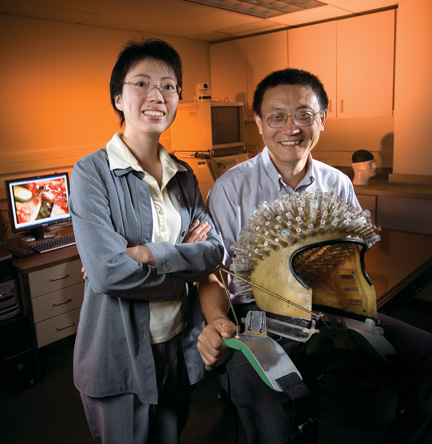
Tracy Cui (left), and Mingui Sun
Though their work is not performed in arenas packed with fans, when it comes to both national recognition and work of global impact, our faculty also had a championship-level year. This is a group that not only sits at the heart of our educational mission, but also continues to make very significant contributions to new knowledge through scholarship and research.
Collectively and comparatively, this was another great year in terms of the research support attracted by members of our faculty. The most recent comparative statistics released by the National Science Foundation reveal that Pitt ranks 11th nationally in terms of total federal science and engineering research and development support. We sit just outside a top 10 that consists of Johns Hopkins, the University of Washington, Penn, UCLA, Michigan, Stanford, the University of California at San Francisco, Duke, Columbia, and Harvard.
In terms of National Institutes of Health (NIH) support attracted by members of our faculty, we moved into sixth place nationally during the past year. The NIH top 10 consists of Harvard, Johns Hopkins, Penn, UCSF, the University of Washington, Pitt, UCLA, Duke, Michigan, and Washington University in St. Louis.
Obviously, we can be very proud to be so well positioned in that distinguished company. However, as you can see, we now are poised to move even higher—into the top 10 in total federal science and engineering research and development support and into the top five in NIH funding. And it is our intention to do both.
Embedded in our large annual research expenditures—which should exceed $630 million this year—is support for very important initiatives. Included in this year’s new federal grants, to give just a few examples, were $8 million to lead the largest study ever of the autoimmune disorder myositis, $16 million to establish an HIV research center, $4.75 million to launch a new center on spinal cord injuries, and $9.6 million to elevate our autism research center into an Autism Center of Excellence.
Moving further away from the numbers, the special forms of recognition won by faculty members across the disciplines during the last year were very impressive. For example:
• David Lewis, UPMC Endowed Professor in Translational Neuroscience and director of our Translational Neuroscience Program, was elected to membership in the Institute of Medicine;
• Isabel Beck, emeritus professor of education and senior scientist in our Learning Research and Development Center, was elected to the National Academy of Education;
• Susan Amara, Thomas Detre Professor of Neuroscience and chair of the Department of Neurobiology; George Klinzing, vice provost for research and W.K. Whiteford Professor of chemical and petroleum engineering; and Ching-Chung Li, professor of electrical and computer engineering and of computer science, were elected fellows of the American Association for the Advancement of Science; and
• And Nuel Belnap, the Alan Ross Anderson Distinguished Professor of Philosophy, was elected a fellow of the American Academy of Arts and Sciences. This is the third consecutive year that a Pitt philosopher has received this honor.
Other high honors received by faculty during the past year include the following:
• Lee Antoinette Darville, professor of pediatrics and immunology, received one of just 12 Individual Biomedical Research Awards from the Hartwell Foundation;
• Toi Derricotte, professor of English, received both the Elizabeth Kray Award from Poets House and the Barnes & Noble Writers for Writers Award;
• Professors William Klunk from the Department of Psychiatry and Chester Mathis from the Department of Radiology received the American Academy of Neurology’s Potamkin Prize (also known as the “Nobel Prize of Neurology”) for their pioneering work in the early diagnosis of Alzheimer’s disease; and
• And Marcus Rediker, chair of the Department of History, received both the Merle Curti Award from the Organization of American Historians and the George Washington Book Prize for his book The Slave Ship: A Human History.
New leaders were recruited to important leadership positions within the University. Among the year’s highlights, for example, were the formal installations of Jem Spectar as president of the University of Pittsburgh at Johnstown and Sharon Smith as president of the University of Pittsburgh at Greensburg.
Well-established faculty members also rose to positions of leadership nationally and internationally. For example:
• David Geller, the Richard L. Simmons Professor of Surgery, was chosen as president-elect of the Society of University Surgeons;
• Patricia Kroboth, dean of our School of Pharmacy, was elected chair of the Council of Deans of the American Association of Colleges of Pharmacy; and
• Jeffrey Schwartz, professor of anthropology and of history and philosophy of science, was installed as president of the
World Academy of Art and Science;
• And Harvey White, from the faculty of the Graduate School of Public and International Affairs, served as president of the American Society for Public Administration.
As impressive as this record of accomplishment by more senior members of the faculty is—and I could add many other examples—one of the most exciting things about the last year was the large number of high honors won by more junior faculty on the basis of their demonstrated potential, showing that the talent in our pipeline is exceptional.
• Pete Rubin, assistant professor of plastic and reconstructive surgery, was chosen by the White House Office of Science and Technology Policy to receive a Presidential Early Career Award for Scientists and Engineers. This is widely considered to be the highest honor bestowed by the federal government on scientists who still are in the early years of their careers.
• Two of just 19 Howard Hughes Medical Institute Physician-Scientist Early Career Awards were received by “Pitt people”—Yvonne Chan, an assistant professor in the Division of Pulmonary, Allergy, and Critical Care Medicine, and Allan Tsung, who currently is a resident in the Department of Surgery and who will join the faculty of our School of Medicine in just a few days.
• Five very talented assistant professors—four from the Swanson School of Engineering and one from the School of Arts and Sciences—won very prestigious Faculty Early Career Development Program awards from the National Science Foundation. They are Tracy Cui from bioengineering, Di Gao from chemical and petroleum engineering, Rebecca Hwa from computer science, Lisa Weiland from mechanical engineering and materials science, and Jun Yang from electrical and computer engineering.
• And Steven Little, assistant professor of chemical engineering, received another very high national honor, a 2008 Beckman Young Investigators Award from the Arnold and Mabel Beckman Foundation, to support his innovative research.
I doubt that we ever have had a year in which so many junior faculty members captured such prestigious national awards.
And, of course, we are doing everything that we can to build not only the culture but also the infrastructure to support our award-winning researchers, whether junior or senior. Among the very visible steps taken to advance our collective research strength during the past year were the creation of our Center for Vaccine Research, the Richard King Mellon Foundation Institute for Pediatric Research, and our new Center for Energy.
At the same time, existing centers of academic excellence continued to distinguish themselves. For example, our European Union Center was redesignated a European Union Center of Excellence by the European Union Delegation of the European Commission. And just last year, as you may recall, all four of our area studies centers—Asian, European, Latin American, and Russian and East European—as well as our International Business Center were competitively redesignated National Resource Centers by the U.S. Department of Education.
The Increasing Importance of Private Support
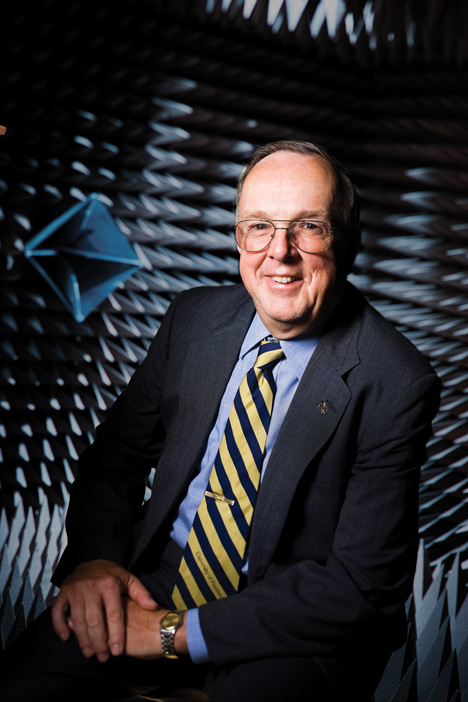
John A. Swanson
We are pressing forward on this ambitious path even though, as you all know, these are very challenging economic times. Our longest-standing competitive disadvantage has been the comparatively low level of support provided by Pennsylvania to its public research universities that has lagged well behind our peers. With a recommended increase to our appropriation of just slightly more than 1 percent in a year when the recommended overall increase to the state budget is 4.2 percent, our assigned priority is low, and the outlook for state support in the next fiscal year is bleak.
More recently, pressures on the federal budget have affected the levels of support available for university research—a trend that is especially troublesome for an institution that is as research-intensive as Pitt. Essentially, we are competing hard, and successfully, to capture an ever-larger share of a federal research “pie” that steadily is being eroded through a significant loss of its purchasing power.
Of course, the University also is affected by the more general problems plaguing the national economy, including rapidly rising utility charges, construction costs, and food prices, among many other things. To date, we have been highly successful at avoiding the specific problems that have plagued many other fine institutions in the troubled capital markets. But our endowment certainly will not experience the levels of growth that we have seen in recent years.
This makes continuing success in private fundraising even more critical. And while the final tallies are not yet in, this year will have been our best year ever in terms of total voluntary support, individual support, foundation support, and the total number of donors. And just 20 months after we burst through the $1 billion barrier, we now have passed the $1.25 billion mark in our $2 billion capital campaign.
Examples of major gifts from the past giving year underscore both the breadth and impact of recent contributions to Pitt.
• As I mentioned just moments ago, the Pittsburgh-based Richard King Mellon Foundation, one of this University’s most generous supporters over the course of many years, made a $23 million gift to Pitt and Children’s Hospital of Pittsburgh of UPMC, permitting us to create the new Richard King Mellon Foundation Institute for Pediatric Research.
• The Bill & Melinda Gates Foundation, which is not locally based and which has not provided major support to Pitt in the past, made two very large grants to us this year, both tied to our new Center for Vaccine Research: an $11.4 million grant to develop new strategies to control tuberculosis and a $10 million grant to support a vaccine modeling initiative.
• A $12 million bequest from an anonymous individual donor has created a permanent endowment to provide scholarship support for commuter students at the University of Pittsburgh at Johnstown.
• And, of course, the high point of the year was the historic $41.3 million gift made by fellow Trustee John Swanson to provide a broad and very flexible form of support to the school that now bears his name—the John A. Swanson School of Engineering.
Though the size of his gift continues to defy comprehension, for those of us who know John and have seen both his extraordinary generosity and his deep sense of commitment to Pitt, the fact that he would make such a surprising gift, if anyone was going to do it, is not so surprising. And speaking more broadly, it also is not surprising that such philanthropic leadership would come from within the Board of Trustees, because this board has played such a key role in leading Pitt forward in virtually every way.
Certainly, the examples of high achievement and broad impact that have come from within this board are inspiring in their own right and underscore, in highly personal and very meaningful ways, the importance of our mission. Let me give just three examples from the past few months.
• Steve Beering became one of this country’s most respected academic leaders during his long and distinguished service as the president of Purdue University. Steve, who also earned his undergraduate degree at Pitt, recently celebrated the 50th anniversary of his graduation from our medical school, as well as the 60th anniversary of his arrival in this country as a teenage immigrant. In the midst of all that celebrating, he also recently was reelected chair of the National Science Board, a critical position in the shaping of this country’s science policy.
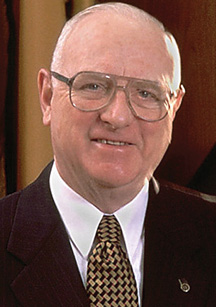
Steven C. Beering
• Our board chair, Ralph Cappy, who also earned two degrees at Pitt, brought nearly three decades of distinguished service as a member of the judiciary to an end when he stepped down as chief justice of the Pennsylvania Supreme Court. As he left that position, honors came to him from virtually every direction. From the National Center for State Courts, he received the Harry L. Carrico Award for Judicial Innovation; the Pennsylvania Bar Association made him just the ninth person in that organization’s 112-year history to receive its Bar Medal; the Philadelphia Bar Association presented him with its top award for distinguished service; and the Women’s Bar Association of Western Pennsylvania honored him with its Susan B. Anthony Award for his efforts to promote equality in the legal profession.
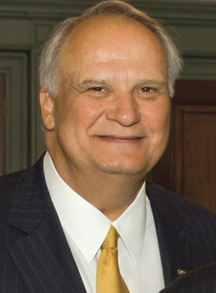
Ralph J. Cappy
• Fellow Trustee Bill Strickland likes to remind us that he enrolled in this University on academic probation but now holds both an earned degree and an honorary doctorate from Pitt. Earlier in the year, right here on campus, he launched the release of his acclaimed autobiography, Make the Impossible Possible: One Man’s Crusade to Inspire Others to Dream Bigger and Achieve the Extraordinary, which became the five millionth book in our University Library System’s collection. At the same time, Bill continued exporting his innovative and effective system of education, not only to other American cities, but also to locations abroad.
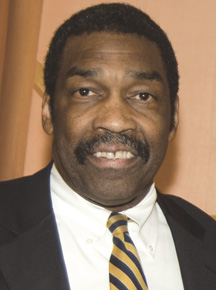
William E. Strickland Jr.
One of my favorite quotes comes from Henry Adams, who once said, “A teacher affects eternity; he can never tell where his influence stops.” These three examples prove that basic point, because the teachers of Steve Beering, Ralph Cappy, and Bill Strickland could not possibly have predicted the scope of their future influence and impact.
Those examples also suggest that we might broaden Mr. Adams’ statement to capture the immense, but incalculable, impact of a major institution like the University of Pittsburgh. Even if we cannot specifically predict each of its products, our collective enterprise—devoted, as it is, to teaching, research, and public service—has been, and will continue to be, an enormous force for good.
Your contributions as trustees, then, should trigger two levels of well-deserved satisfaction. Think, for example, about the levels of quality that have been achieved, the facilities that have been constructed, the campuses that have been beautified, the communities that have been enriched, the extraordinary work that has been supported, and the countless lives that have been touched. Measured purely in terms of current impact, this already is an exceptional record.
Our goals, though, always have extended beyond building for today. Instead, particularly with Pitt’s proud 221-year history to inform us, we understand that we also are building for a far more extended future. In doing so, we are driven by our shared belief that, if we can continue to build our momentum—by working hard, by working smart, and, most importantly, by working together—for our University and for the countless people who will be touched by our University, the best is yet to come!
Other Stories From This Issue
On the Freedom Road

Follow a group of Pitt students on the Returning to the Roots of Civil Rights bus tour, a nine-day, 2,300-mile journey crisscrossing five states.
Day 1: The Awakening
Day 2: Deep Impressions
Day 3: Music, Montgomery, and More
Day 4: Looking Back, Looking Forward
Day 5: Learning to Remember
Day 6: The Mountaintop
Day 7: Slavery and Beyond
Day 8: Lessons to Bring Home
Day 9: Final Lessons

